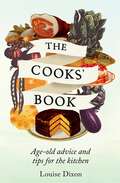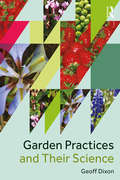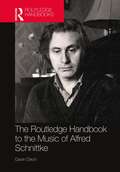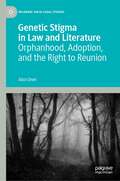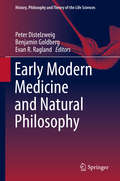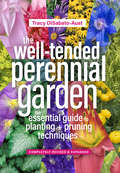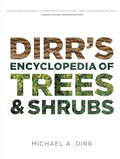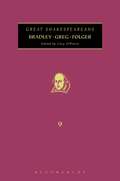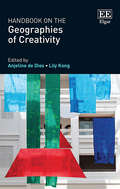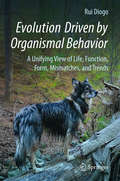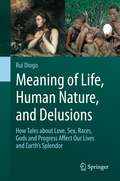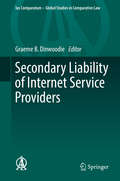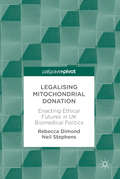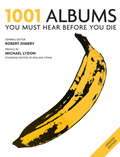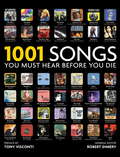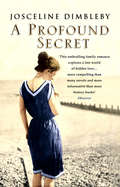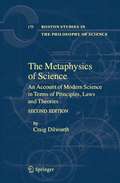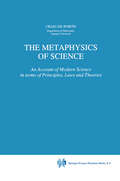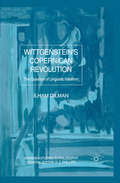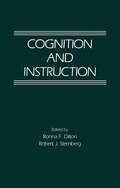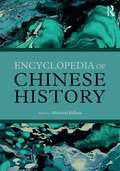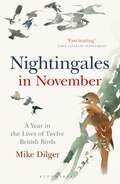- Table View
- List View
The Cooks' Book: Age-old advice and tips for the kitchen
by Louise DixonWhether you want to get back to basics, throw away the ready-meals and cook some traditional tasties, or you are simply interested in studying the old tried-and-tested methods used in the good old days, The Cooks' Book has the wisdom and advice of the trained chef at your disposal. This book is a treasure trove of information that will bring out the best in everyone in the kitchen. From advice on food hygiene, handling and preparation to techniques and tricks to help your bread rise and your pies taste just like Grandma made them. Also includes, old, new - and some surprising - uses for store cupboard staples, some tips and tricks for successful jams, preserves and pickles and important storage and reheating advice at your fingertips.
Garden Practices and Their Science
by Geoff DixonWritten in a clear and accessible style, Garden Practices and Their Science guides gardeners in the practical arts of plant husbandry and in their understanding of its underpinning principles. The author, Professor Geoff Dixon, is an acknowledged and internationally respected horticulturist and microbiologist; he intertwines these arts and principles carefully, expertly leading readers from one to the other. Achieving the manipulation of plant life is described in eight full-colour, well-illustrated chapters covering the growing of potatoes, bulb onions, legumes, small-seeded vegetables, soft fruit, bulbs and herbaceous ornamentals in great detail. Environmental factors controlling the successful husbandry of these crops is described in simple, non-technical language, increasing gardeners’ enjoyment and competence. Gardeners are also informed of the tools and equipment they require and their safe use. Also provided are a series of simple, straightforward tests identifying the aerial and soil environments beneficial for plant growth using readily accessible domestic tools. Discussions of very straightforward techniques for vegetative propagation conclude this book. Each chapter ends with a list of the gardening knowledge that has been gained by readers. The structure of this book fulfils a longstanding need for descriptions of practical skills integrated with the corresponding biological reactions of plants. Emphasis is placed on gardeners’ development of healthy soils, which encourage vigorous, active root systems capable of withstanding stresses—an aspect of gardening that rarely receives sufficient attention. Tailored for readers requiring clear and concise directions, this very practical book is an instruction manual directed at early-stage gardening learners. These include people of all ages and requirements such as new garden owners, allotment-holders, apprentices and students of basic levels in the Royal Horticultural Society’s or City & Guilds qualifications, career changers, community gardeners and those needing applied biological knowledge for GCSE examinations.
Garden Practices and Their Science
by Geoff DixonWritten in a clear and accessible style, Garden Practices and Their Science guides gardeners in the practical arts of plant husbandry and in their understanding of its underpinning principles. The author, Professor Geoff Dixon, is an acknowledged and internationally respected horticulturist and microbiologist; he intertwines these arts and principles carefully, expertly leading readers from one to the other. Achieving the manipulation of plant life is described in eight full-colour, well-illustrated chapters covering the growing of potatoes, bulb onions, legumes, small-seeded vegetables, soft fruit, bulbs and herbaceous ornamentals in great detail. Environmental factors controlling the successful husbandry of these crops is described in simple, non-technical language, increasing gardeners’ enjoyment and competence. Gardeners are also informed of the tools and equipment they require and their safe use. Also provided are a series of simple, straightforward tests identifying the aerial and soil environments beneficial for plant growth using readily accessible domestic tools. Discussions of very straightforward techniques for vegetative propagation conclude this book. Each chapter ends with a list of the gardening knowledge that has been gained by readers. The structure of this book fulfils a longstanding need for descriptions of practical skills integrated with the corresponding biological reactions of plants. Emphasis is placed on gardeners’ development of healthy soils, which encourage vigorous, active root systems capable of withstanding stresses—an aspect of gardening that rarely receives sufficient attention. Tailored for readers requiring clear and concise directions, this very practical book is an instruction manual directed at early-stage gardening learners. These include people of all ages and requirements such as new garden owners, allotment-holders, apprentices and students of basic levels in the Royal Horticultural Society’s or City & Guilds qualifications, career changers, community gardeners and those needing applied biological knowledge for GCSE examinations.
The Routledge Handbook to the Music of Alfred Schnittke (Routledge Russian and East European Music and Culture)
by Gavin DixonThe Routledge Handbook to the Music of Alfred Schnittke is a comprehensive study of the work of one of the most important Russian composers of the late 20th century. Each piece is discussed in detail, with particular attention to the composer’s groundbreaking polystylism, as well as his unique approach to musical symbolism and his deep engagement with Christian themes. This is the first publication to look at Schnittke’s output in its entirety, and for most works it represents either the first ever published analysis or the first in a language other than Russian. The volume presents new research from the Ivashkin-Schnittke Archive at Goldsmiths, University of London and the collection of Schnittke’s compositional sketches at the Julliard Library in New York. It also draws on the substantial research on Schnittke’s music published in the Russian language. Including a work list and bibliography of primary and secondary sources, this is an essential reference for all those interested in Russian music, 20th-century music and performance studies.
The Routledge Handbook to the Music of Alfred Schnittke (Routledge Russian and East European Music and Culture)
by Gavin DixonThe Routledge Handbook to the Music of Alfred Schnittke is a comprehensive study of the work of one of the most important Russian composers of the late 20th century. Each piece is discussed in detail, with particular attention to the composer’s groundbreaking polystylism, as well as his unique approach to musical symbolism and his deep engagement with Christian themes. This is the first publication to look at Schnittke’s output in its entirety, and for most works it represents either the first ever published analysis or the first in a language other than Russian. The volume presents new research from the Ivashkin-Schnittke Archive at Goldsmiths, University of London and the collection of Schnittke’s compositional sketches at the Julliard Library in New York. It also draws on the substantial research on Schnittke’s music published in the Russian language. Including a work list and bibliography of primary and secondary sources, this is an essential reference for all those interested in Russian music, 20th-century music and performance studies.
Genetic Stigma in Law and Literature: Orphanhood, Adoption, and the Right to Reunion (Palgrave Socio-Legal Studies)
by Alice DiverThis book critically analyses the way in which traditional sociocultural and legal biases might be perpetuated against those with unknown – or unknowable – genetic ancestries. It looks to law and works of literature across differing eras and genres focussing upon such concepts as inherited stigma, illegitimacy, orphanisation, adoption, othering, reunion, and the ‘right’ to access truths that relate to one’s original identity. Law’s role in such matters is often limited (or usurped) by custom, practice, or lingering superstitious beliefs; the importance of oral and written testimony is therefore highlighted. Characters include abandoned or orphaned figures from folk and fairy tales, Romantic and Victorian monsters and heroes, Dickensian waifs, Edwardian rescue orphans, and dystopia-set ‘rebels.‘ Their insights and experiences are mirrored in various present day scenarios that speak to familial human rights abuses, not least forced adoptions and bars on accessing original information. This cross-disciplinary book drawing on Law, Literature, Sociology, Critical Adoption Studies should be of interest to those interested in and those who have been affected in some way by adoption, origin deprivation, or reunion.
Early Modern Medicine and Natural Philosophy (History, Philosophy and Theory of the Life Sciences #14)
by Peter Distelzweig Benjamin Goldberg Evan R. RaglandThis volume presents an innovative look at early modern medicine and natural philosophy as historically interrelated developments. The individual chapters chart this interrelation in a variety of contexts, from the Humanists who drew on Hippocrates, Galen, and Aristotle to answer philosophical and medical questions, to medical debates on the limits and power of mechanism, and on to eighteenth-century controversies over medical materialism and 'atheism.'The work presented here broadens our understanding of both philosophy and medicine in this period by illustrating the ways these disciplines were in deep theoretical and methodological dialogue and by demonstrating the importance of this dialogue for understanding their history.Taken together, these papers argue that to overlook the medical context of natural philosophy and the philosophical context of medicine is to overlook fundamentally important aspects of these intellectual endeavors.
The Well-Tended Perennial Garden: The Essential Guide to Planting and Pruning Techniques, Third Edition
by Tracy DiSabato-AustThis completely revised third edition of the bestselling classic The Well-Tended Perennial Garden is a must-have ally in the quest for a beautiful, well-maintained garden.
Dirr's Encyclopedia of Trees and Shrubs
by Michael A. DirrA combination of Dirr's bestselling books under one cover, adding new plants, new photographs, plus all new commentary in Dirr's signature style, Dirr's Encyclopedia of Trees and Shrubs is the bible of woody plants.
Bradley, Greg, Folger: Great Shakespeareans: Volume IX (Great Shakespeareans)
by Cary DiPietroA comprehensive critical analysis of the most important Shakespearean critics, editors, actors and directors. This volume focuses on Shakespeare's reception by Bradley, Greg and Folger.
Bradley, Greg, Folger: Great Shakespeareans: Volume IX (Great Shakespeareans)
by Cary DiPietroA comprehensive critical analysis of the most important Shakespearean critics, editors, actors and directors. This volume focuses on Shakespeare's reception by Bradley, Greg and Folger.
Handbook on the Geographies of Creativity
by Anjeline De Dios Lily KongAdopting a geographically diverse and theoretically rigorous approach, this Handbook on the Geographies of Creativity is a cutting-edge study of creativity as it has emerged in policy, academic, activist, and cultural discourse over the last two decades. A range of sectors are explored with in-depth engagement and understanding, including: dance, music, craft, visual art, circus arts and fashion. This Handbook departs from conventional modes of analysing creativity by industry, region or sector, and instead identifies key themes that thread through shifting contexts of the creative, namely creativity as imaginary, locality, mobility, labour, culture, intervention and method. By tracing the myriad spatialities of creativity, the chapters map its inherently paradoxical features: reinforcing persistent conditions of inequality even as it opens avenues for imagining and enacting more equitable futures. The conceptual framework proposed for critically appraising present debates and articulating future directions for creative and cultural industries will be useful for scholars and academics researching culture, media and design. Policy makers and professionals working in creative and cultural industries (CCIs) will find the wide range of case studies in this Handbook an essential tool for further understanding the field.
Evolution Driven by Organismal Behavior: A Unifying View of Life, Function, Form, Mismatches and Trends
by Rui DiogoThis book proposes a new way to think about evolution. The author carefully brings together evidence from diverse fields of science. In the process, he bridges the gaps between many different--and usually seen as conflicting--ideas to present one integrative theory named ONCE, which stands for Organic Nonoptimal Constrained Evolution. The author argues that evolution is mainly driven by the behavioral choices and persistence of organisms themselves, in a process in which Darwinian natural selection is mainly a secondary--but still crucial--evolutionary player. Within ONCE, evolution is therefore generally made of mistakes and mismatches and trial-and-error situations, and is not a process where organisms engage in an incessant, suffocating struggle in which they can't thrive if they are not optimally adapted to their habitats and the external environment. Therefore, this unifying view incorporates a more comprehensive view of the diversity and complexity of life by stressing that organisms are not merely passive evolutionary players under the rule of external factors. This insightful and well-reasoned argument is based on numerous fascinating case studies from a wide range of organisms, including bacteria, plants, insects and diverse examples from the evolution of our own species. The book has an appeal to researchers, students, teachers, and those with an interest in the history and philosophy of science, as well as to the broader public, as it brings life back into biology by emphasizing that organisms, including humans, are the key active players in evolution and thus in the future of life on this wonderful planet.
Meaning of Life, Human Nature, and Delusions: How Tales about Love, Sex, Races, Gods and Progress Affect Our Lives and Earth's Splendor
by Rui DiogoWhatever are your beliefs, background, education, political views or interests, one thing is sure: this book will engage you, teach you something new, and more importantly make you to re-think deeply about critical aspects of your daily-life, including sex, love, food, physical activities, diseases, work and stress, and how you see and deal with other people, other animals, and the planet in general. Indeed, it focuses on topics that have fascinated people from all places and historical periods since times immemorial: Why are we here? What is the meaning of life? Are we progressing, and will we thrive? It does this by integrating in a unique fashion information from ancient Greek, Sumerian, Hindu, Jewish, Buddhist, Christian and Muslim texts to high-tech brain research, facts about near-death experiences, Covid-19, QAnon conspiracies, virtual reality and dating aps; from Adam and Eve to the rise of misogyny and racism to Black Lives Matter, Me-Too, Hollywood romantic movies and Disney fairy-tales. Contrary to notions about 'human progress' and 'Homo Deus' defended by authors such as Harari, Pinker and Dawkins, it shows that human history instead involves the repetition of similar imaginary tales created by a combination of traits found in other animals and the uniquely human obsession about 'cosmic purpose' stories related to our awareness of death's inevitability. Organized religions appeared later, chiefly during the rise of agriculture and 'civilizations'. Diogo navigates mesmerizing untold stories revealing a paradox: these events and the industrial 'revolution' increased inequality, oppression, slavery, subjugation of women, famines, plagues, 'work', stress, and suicides. Data from psychology, biology, neurobiology, and cross-cultural studies of hunter-gatherers and so-called 'developed' societies reveal an even more profound paradox: within all forms of life, the 'sapient being' is the one immersed in Neverland's world of unreality - truly a Homo irrationalis, fictus and socialis believing in fictional tales about cosmic 'duties', 'romantic meant to be', demons, inferior 'races' and 'genders', conspiracies, and 'justified' slavery, warfare, genocides, and animal abuses. Importantly, such tales play, on the other hand, crucial functions such as help coping with death and a plethora of societal troubles, decreasing stress, or preventing drug and alcohol abuse. An optimist and passionate wondered and wanderer, Diogo provides enthralling details about the history of religion, discrimination, romantic love, warfare, diseases and Earth's biodiversity illustrating how 'virtue is in the middle' and that we - with our intriguing combination of beliefs, bodily needs and desires, artistic abilities, and mismatches between our senses' illusions and the cosmos' reality - are not 'better' or 'worse' than the other millions of captivating living species. This powerful and urgently needed message has critical repercussions for how we understand, care about, and mindfully enjoy living in this splendid planet, in the reality of here and now.Pre-publication comments: "I applaud the enormous work that Diogo has invested in this follow-up to his widely acclaimed Evolution driven by organismal behavior book, and the challenge of getting people to think beyond and outside of our usual set of definitions and expectations. The case-studies provided in the book are fascinating and insightful" (Drew Noden, Award-winning Emeritus Professor, Cornell University)"Rui Diogo is becoming the Slavoj Zizek of evolutionary biology" (Marcelo Sanchez-Villagra, Director of the Paleontological Institute and Museum of the University of Zurich)
Secondary Liability of Internet Service Providers (Ius Comparatum - Global Studies in Comparative Law #25)
by Graeme B. DinwoodieThis book analyses the doctrinal structure and content of secondary liability rules that hold internet service providers liable for the conduct of others, including the safe harbours (or immunities) of which they may take advantage, and the range of remedies that can be secured against such providers. Many such claims involve intellectual property infringement, but the treatment extends beyond that field of law. Because there are few formal international standards which govern the question of secondary liability, comprehension of the international landscape requires treatment of a broad range of national approaches. This book thus canvasses numerous jurisdictions across several continents, but presents these comparative studies thematically to highlight evolving commonalities and trans-border commercial practices that exist despite the lack of hard international law. The analysis presented in this book allows exploration not only of contemporary debates about the appropriate policy levers through which to regulate intermediaries, but also about the conceptual character of secondary liability rules.
Legalising Mitochondrial Donation
by Rebecca Dimond Neil StephensIn 2015 the UK became the first country in the world to legalise mitochondrial donation, a controversial germ line reproductive technology to prevent the transmission of mitochondrial disease. Dimond and Stephens track the intense period of scientific and ethical review, public consultation and parliamentary debates preceeding the decision. They draw on stakeholder accounts and public documents to explore how patients, professionals, institutions and publics mobilised within ‘for’ and ‘against’ clusters, engaging in extensive promissory, emotional, bureaucratic, ethical, embodied and clinical labour to justify competing visions of an ethical future. They describe how this decision is the latest iteration of a UK sociotechnical imaginary in which the further liberalization of human embryo research and use is rendered legitimate and ethical through modes of consultation and permissive but strictly regulated licensing. Overall, this book presents a timely, multi-dimensional, and sociological account of a globally significant landmark in the history of human genetics, and will be relevant to those with an interest in genetics, Science, Technology and Society, the sociology of medicine, reproductive technology, and public policy debate.
1001 Albums You Must Hear Before You Die: You Must Hear Before You Die (1001)
by Robert DimeryWhat did Time magazine consider the twentieth-century's greatest album? Which anthem by Prince was an attempt to emulate Bob Seger? And what links Count Basie and Batman?If you thought you knew your music, then think again. 1001Albums You Must Hear Before You Die, is totally revised and fully updated for 2013, and is the definitive guide to accompany your interest in music. Written by top UK and US music journalists, and includes a preface by Michael Lydon, the founding editor of the Rolling Stone magazine. It celebrates the great and ground-breaking albums throughout the eras - from the genesis of Fifties rock 'n' roll to the technological and electronic innovations of the 2000s.Each entry includes key tracks and explains exactly why each of these albums deserved to be included in the list, offering an insight into the process of their creation, development, and success. With albums from Elvis Presley, Frank Sinatra, Miles Davis, The Rolling Stones, Bob Dylan, The Sex Pistols, ACDC, Ray Price, the Beach Boys, Sonic Youth, P J Harvey, Jack White, Green Day, Christina Aguilera, and the latest from David Bowie, as well as new cutting-edge entries such as Kendrick Lamar and Django Django, 1001 Albums You Must Hear Before You Die covers all the works that have formed part of the soundtracks to all our lives, at one point or another.Illustrated with more than 900 iconic images of album covers, bands and artists, as well as photographs from many legendary gigs, 1001 Albums You Must Hear Before You Die, covers from the 1950s to the present and is the single most comprehensive list of music that changed the world, an absolute must-have for all the musically inspired.
1001 Songs: You Must Hear Before You Die (1001)
by Robert DimeryWhat links Lead Belly, Lonnie Donegan and Black Betty? Whose gravestoneinspired Phil Spector's first hit? And for which song did Johnny Rotten replace the singer from Def Leppard?The rich history of popular music is built on a foundation of classic songs. From Tin Pan Alley to the Brill Building, Bob Dylan to Kurt Cobain, and Joni Mitchell to Amy Winehouse, gifted songwriters have crafted a cherished body of music that has become part of our lives. Imagine the Fifties without the magical clamor of "Tutti Frutti" and "Hound Dog" the Seventies without the anthemic "Le Freak" and "Anarchy in the UK" or the Noughties without the Leftfield pop of "Toxic" or "Crazy". This music mirrors the times, both reflecting society at large ("A Change is Gonna Come", "The Message") and mapping our own personal highs ("God Only Knows") or lows ("Hurt"). And from 'Saturday Night Fish Fry' to Saturday Night Fever, it has helped us simply forget our problems.1001 Songs You Must Hear Before You Diepicks through nearly a century of music to bring you an inspiring selection of some of the greatest recordings ever made. Each entry in this wonderfully browsable book tells the story of a great song. Find out what inspired the songwriter, what makes the track so enduring, which songs it influenced in turn and which cover version to listen out for. You'll also pick up a wealth of fascinating trivia along the way.
A Profound Secret: May Gaskell, her daughter Amy, and Edward Burne-Jones
by Josceline DimblebyA chance encounter with Andrew Lloyd Webber at a summer party sent Josceline Dimbleby on a quest to uncover a mystery in her own family's past. Her great-aunt Amy Gaskell was the subject of a beautiful dark portrait by the Pre-Raphaelite painter Edward Burne-Jones, but all that was known about Amy, according to family lore, was that she had 'died young of a broken heart'.In her search, Josceline discovered a cache of unpublished letters from Burne-Jones to her great-grandmother May Gaskell, Amy's mother.They formed a passionate and prolific correspondence, of up to five letters a day, from the last six years of the painter's life. As she read, more and more questions were raised: why did Burne-Jones feel he had to protect May from an overwhelming sadness? What was the deep secret she had confided to him? And what was the tragic truth behind beautiful Amy's wayward, wandering life, her strange marriage and her unexplained early death?
The Metaphysics of Science: An Account of Modern Science in Terms of Principles, Laws and Theories (Boston Studies in the Philosophy and History of Science #173)
by Craig DilworthThis book provides a clear, well-founded conception of modern science. The views advanced are not only novel, but they constitute an alternative that is superior to both the empiric-analytic and the sociology of knowledge approaches that are prevalent today. Furthermore, the book provides a resolution of the long-standing debate between empiricism and realism, and it gives a coherent view that transcends the boundaries of the professional philosophy of science.
The Metaphysics of Science: An Account of Modern Science in terms of Principles, Laws and Theories (Boston Studies in the Philosophy and History of Science #173)
by Craig DilworthThe roots of this work lie in my earlier book, Scientific Progress, which first appeared in 1981. One of its topics, the distinction between scientific laws and theories, is there treated with reference to the same distinction as drawn by N. R. Campbell in his Physics: The Elements. Shortly after completing Scientific Progress, I read Rom Harre's The Principles of Scientific Thinking, in which the concept of theory is even more clearly delineated than in Campbell, being directly con nected to the notion of a model - as it was in my book. In subsequent considerations regarding science, Harre's work thus became my main source of inspiration with regard to theories, while Campbell's re mained my main source with respect to empiricallaws. Around the same time I also read William Whewell's Philosophy of the Inductive Sciences. In this work, Whewell depicts principles as playing a central role in the formation of science, and conceives of them in much the same way as Kant conceives of fundamental syn thetic a priori judgements. The idea that science should have principles as a basic element immediately made sense to me, and from that time I have thought of science in terms of laws, theories and principles.
Wittgenstein's Copernican Revolution: The Question of Linguistic Idealism (Swansea Studies in Philosophy)
by I. DilmanWittgenstein's Copernican Revolution is concerned with how one is to conceive of the relation between language and reality without embracing Linguistic Realism and without courting any form of Linguistic Idealism either. It argues that this is precisely what Wittgenstein does and also examines some well known contemporary philosophers who have been concerned with this same question.
Cognition and Instruction
by Ronna F. Dillon Robert J. SternbergCognition and Instruction focuses on the relationship of knowledge acquisition processes with instruction, including reading, writing, mathematics, curriculum design and reform, and reasoning. The selection first takes a look at the issues in cognitive psychology and instruction, reading, and writing. Discussions focus on the processes of knowledge acquisition, cognitive prescriptions for teaching, cognitive components of reading, instruction in reading, distinctive nature of higher order mental activity in written composition, and knowledge-transforming procedures within the general context of higher order skills. The publication also offers information on second language and mathematics. The text ponders on science, social studies, and art. Topics include psychological research related to curriculum design, science curriculum reform, curriculum and instructional components of social studies and social sciences, evidence for individual styles in young children, educational considerations, and concept of style. The text then examines music and reasoning. The selection is a valuable source of data for readers and cognitive psychologists pursuing research on the relationship of cognition and instruction. The most recent developments in cognitive psychologyUp-to-date literature reviewsChapter on training reasoningActive, renowned contributing authors
Encyclopedia of Chinese History
by Michael DillonChina has become accessible to the west in the last twenty years in a way that was not possible in the previous thirty. The number of westerners travelling to China to study, for business or for tourism has increased dramatically and there has been a corresponding increase in interest in Chinese culture, society and economy and increasing coverage of contemporary China in the media. Our understanding of China’s history has also been evolving. The study of history in the People’s Republic of China during the Mao Zedong period was strictly regulated and primary sources were rarely available to westerners or even to most Chinese historians. Now that the Chinese archives are open to researchers, there is a growing body of academic expertise on history in China that is open to western analysis and historical methods. This has in many ways changed the way that Chinese history, particularly the modern period, is viewed. The Encyclopedia of Chinese History covers the entire span of Chinese history from the period known primarily through archaeology to the present day. Treating Chinese history in the broadest sense, the Encyclopedia includes coverage of the frontier regions of Manchuria, Mongolia, Xinjiang and Tibet that have played such an important role in the history of China Proper and will also include material on Taiwan, and on the Chinese diaspora. In A-Z format with entries written by experts in the field of Chinese Studies, the Encyclopedia will be an invaluable resource for students of Chinese history, politics and culture.
Nightingales in November: A Year in the Lives of Twelve British Birds
by Mike DilgerHave you ever wondered what 'our' birds get up to when they're not pinching our peanuts, pilfering our pyracantha berries or nesting under the eaves of our homes? The One Show's natural history star Mike Dilger tells us the answers in Nightingales in November. This brilliant almanac tells the very different personal and annual stories of twelve well-known birds we deign to call 'British'. Through a lyrical narrative, Nightingales in November showcases amazing avian facts gleaned over decades by birdwatchers, ringers, nest recorders and migration recorders. The perfect 'dip-into' book, any enquiring naturalist will be able to find out such facts as where British-breeding swallows spend Christmas Day, when to look out for juvenile tawny owls, or when is the best date in the calendar to listen out for nightingales. By using a combination of cutting-edge satellite technology and millions of ringing records, Nightingales in November reveals the mysteries of migration, tracking the regular movements of, for example, cuckoos for the eight months they're not in the UK, or divulging why not all robins are the 'stay-at-home' territorial types we once imagined. Illustrated throughout by Darren Woodhead, the birds featured include a rich mix of resident birds, summer visitors, winter visitors and passage migrants. Nightingales in November is a great read for anyone with a fondness for British birds.
